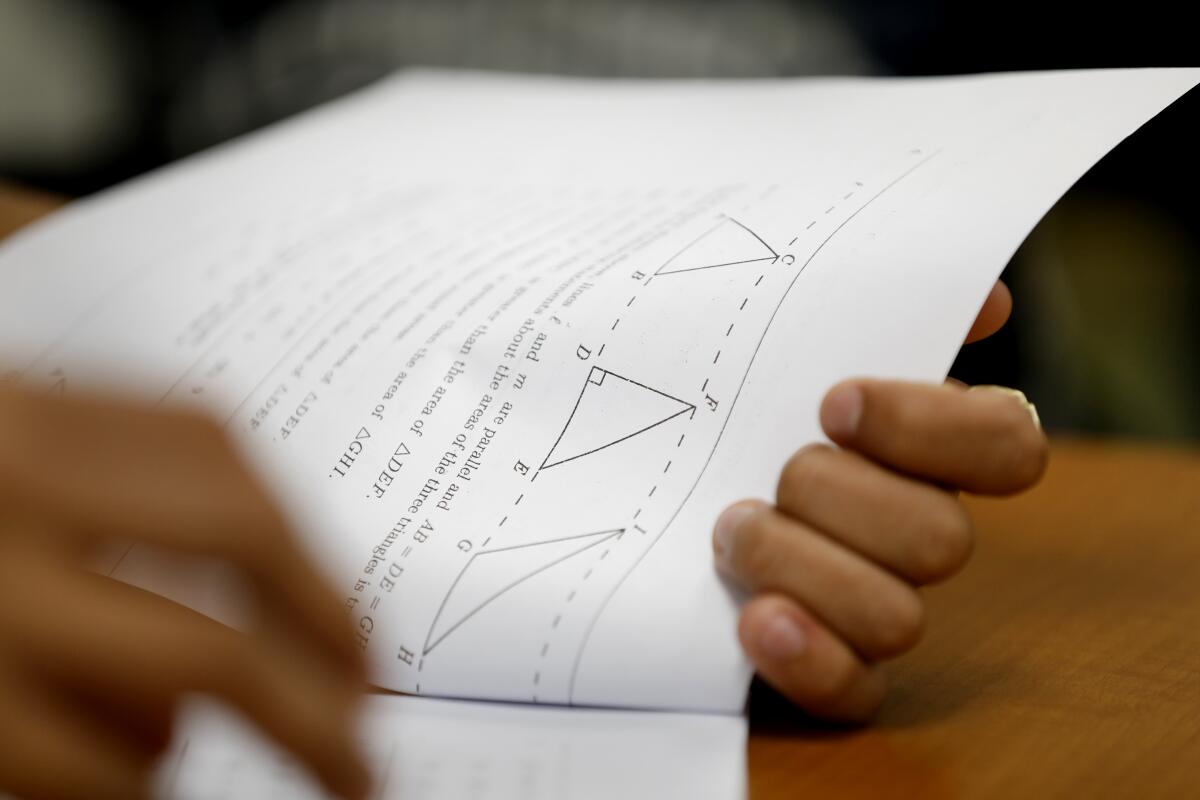I only took three years of high school math, escaped with a ‘D’ and turned out OK

I’ve never managed to master much beyond the nuts and bolts of math. I was an honor student who could ace almost every subject, but ninth-grade geometry tripped me up. I slipped through with a C, but needed three tries to pass trigonometry, with a D.
I couldn’t understand the point of all that mathematical mumbo jumbo. And not once in the 40 years since I finished school have I ever been asked to factor a polynomial or calculate the cosine of anything.
Maybe that’s why I’m not convinced that every California State University-bound student needs four years of high school math or quantitative reasoning courses just to be considered for admission.
Do we really want to keep students like me out of college because of an obsession with the supremacy of STEM? After all, there are still plenty of careers that don’t require expertise in the meaning of imaginary numbers or the minutiae of quadratic equations.
As I followed the debate these past months about whether Cal State should raise admission standards by requiring an additional year of math, I couldn’t help but think back to all those nights I spent hunched over homework, feeling dumb because I couldn’t get my head around complicated formulas that I would never need.
I get the goal of the university’s proposed change: to better prepare students to tackle college courses that can lead to high-demand careers in science, technology, engineering and math.
But I think the CSU trustees made a wise move in delaying their decision until they study how it might affect prospective applicants.
The primary complaint, from educators and activists, is that the new standard would disproportionately disadvantage black, Latino and low-income students, who tend to score lower than whites and Asians on standardized math exams — and who are also more likely to attend schools with less experienced teachers, more crowded classes and fewer high-level math courses.
But this is more than an issue of equity. High school is too late to raise the bar.
Fewer than one-third of California’s 11th-graders met grade-level standards in math last year. Scores were up a bit from previous years. But one troubling trend persists. Students post middling math scores in third grade, but their performance drops every year after that.
Instead of toughening standards at the tail end of their journey, how about we better equip them early on to meet the standards we’ve already got?
**
It’s been a long time since I’ve been in a math class, so I sought out one of California’s most accomplished math teachers to school me on why our students lag so far behind the goals we’ve set.
Brian Shay has taught all levels of math at San Diego’s Canyon Crest Academy, a public high school with 2,500 students. He was a finalist last year for a national award for excellence in math teaching, he’s helped develop California’s math content and standards, and he mentored hundreds of teachers during his 20-year career.
Shay thinks it would “definitely be a challenge” for many students to successfully tackle another year of high school math. But he also thinks that with a little flexibility, the requirement would be a good thing.
It doesn’t have to be calculus or trigonometry, he said. “It could be a class that teaches life skills, like financial math, or follows a scientific passion,” he said. “It’s intended to build the mind-set of problem solving in real situations, like how does interest compound or what calculations you need on a construction project. “
He believes our dismal math scores would rise over time if we employed that real-world mind-set at every level of math instruction — and if we put as much energy into preparing and supporting teachers as we spend worrying about students’ career choices.
I was surprised to learn that research has shown that many teachers, particularly in elementary school, suffer from unaddressed math anxiety themselves. As a result, they tend to teach in an inflexible manner, discourage questions and focus on rote learning, studies found. Their discomfort can stifle student learning.
“The best way to learn math is to explore and play with it,” Shay explained. “It’s the same way people in science understand how chemicals work, or in language how symbolism works.”
Teachers may need more and better training to move past the conventional textbook-based approach and embrace new ways of connecting with students, he said.
“One of the biggest challenges is that the way we learned math in the past is not the most effective way to learn now,” said Shay, who was taught to “parrot” whatever the teacher said.
“A lot of us just teach the way we learned: ‘Here’s a quadratic formula, so use it to solve these equations.’ But mathematics is a way of thinking about facts and logic,” he said. “There’s no one right route to that single perfect solution.”
Creating lessons that every child can learn from is a challenge for teachers, Shay said. In his courses, he aims to open every class with a project. “Low floor, high ceiling, so everyone can access it and start from wherever they’re at,” he said.
He may have students still struggling with fractions in a class with others who are ready for calculus. “So some will do the basic steps, and others will go a little further. That way the advanced students aren’t bored and the students who need more support aren’t so disheartened that they give up,” he said.
“The best thing to do in a math class is to give all kids an opportunity to find success.”
**
California already has a high-minded conceptual blueprint for teaching math, rooted in the sort of quantitative reasoning skills the CSU system is trying to promote.
And if that isn’t enough, our state’s ambitious science standards also emphasize real-world experimentation and discovery over textbooks and tests.
But we can’t pretend we’re preparing kids for college success or for STEM careers when only 32% of California 11th-graders are up to par in math and 30.4% are meeting science standards, according to the state’s 2019 standardized tests.
It seems to me that education policymakers have done the easy part, but haven’t completed the task. We have a destination, but no strong and unified path toward it.
Our progressive plans are undercut by California’s challenges: many poorly resourced schools, a practice of passing students with weak skills along to the next grade without help, and a shortage of skilled math teachers encouraged to enlist the creativity that diverse classrooms demand.
We’re left with the consequences of standards without training. And adding a tough new class won’t remedy that.
Because success in college, career and life rests not on how many math courses we require in high school, but on whether we’re successful at building confidence and competence in students and teachers from the start.
More to Read
Start your day right
Sign up for Essential California for news, features and recommendations from the L.A. Times and beyond in your inbox six days a week.
You may occasionally receive promotional content from the Los Angeles Times.






